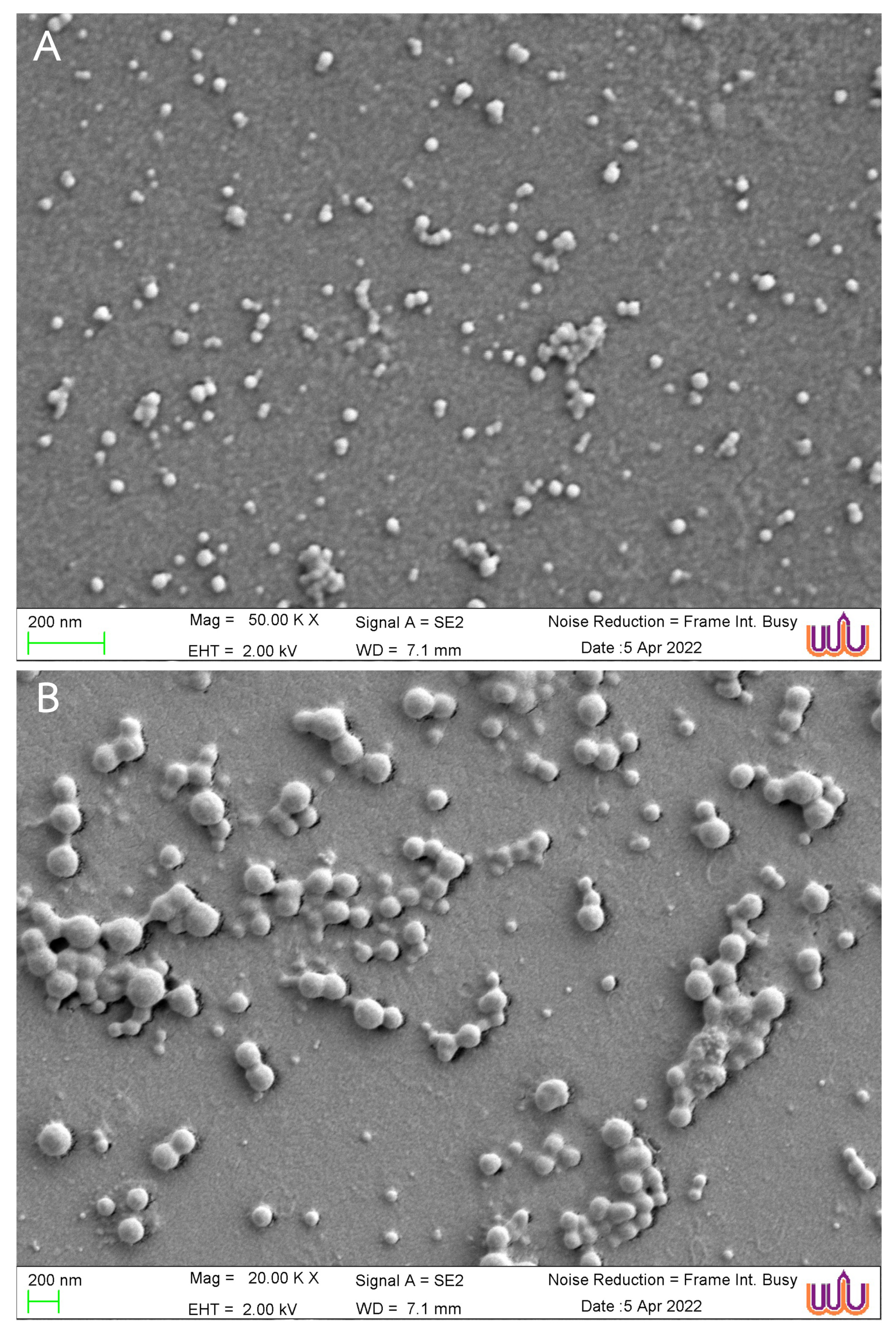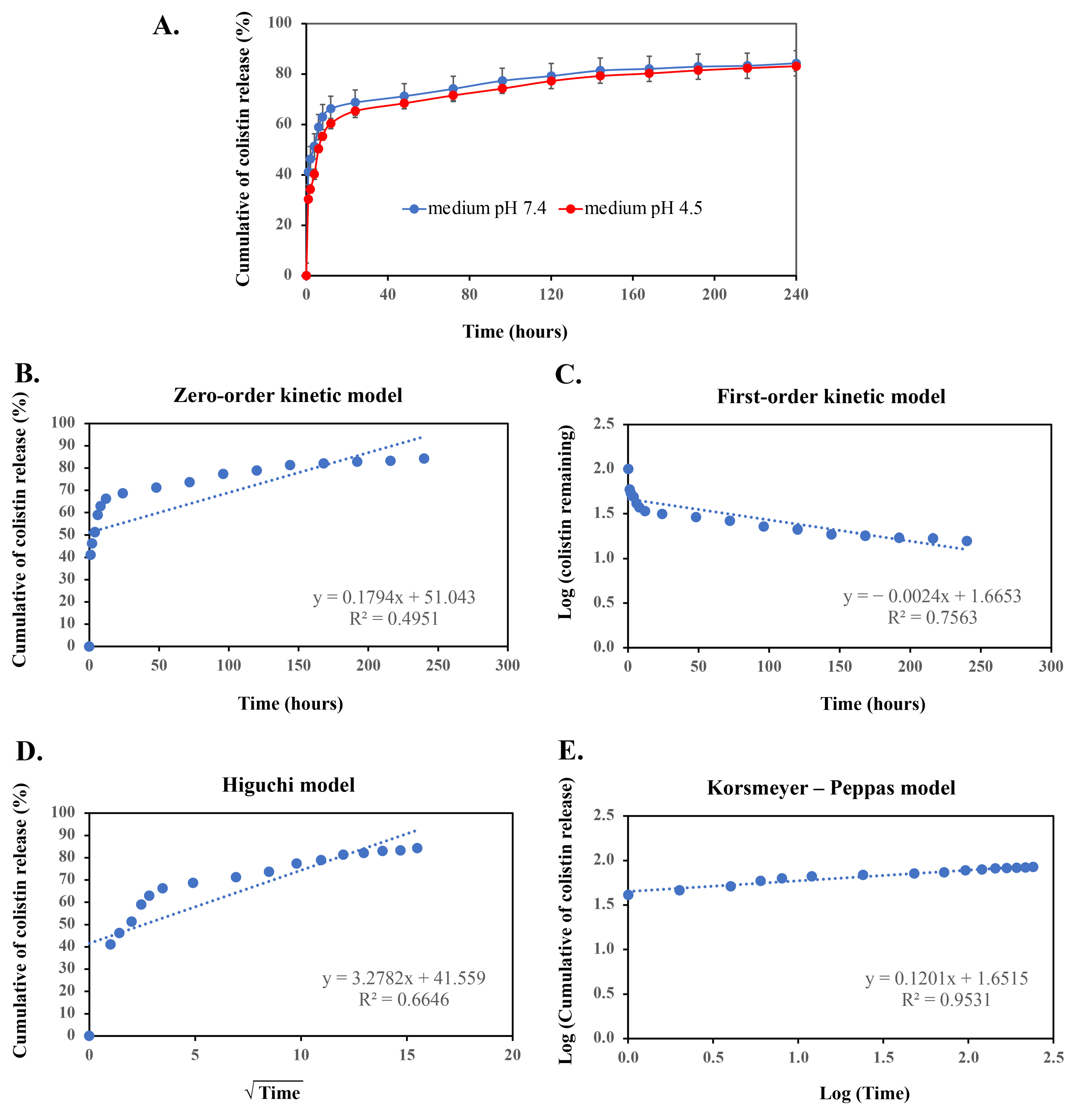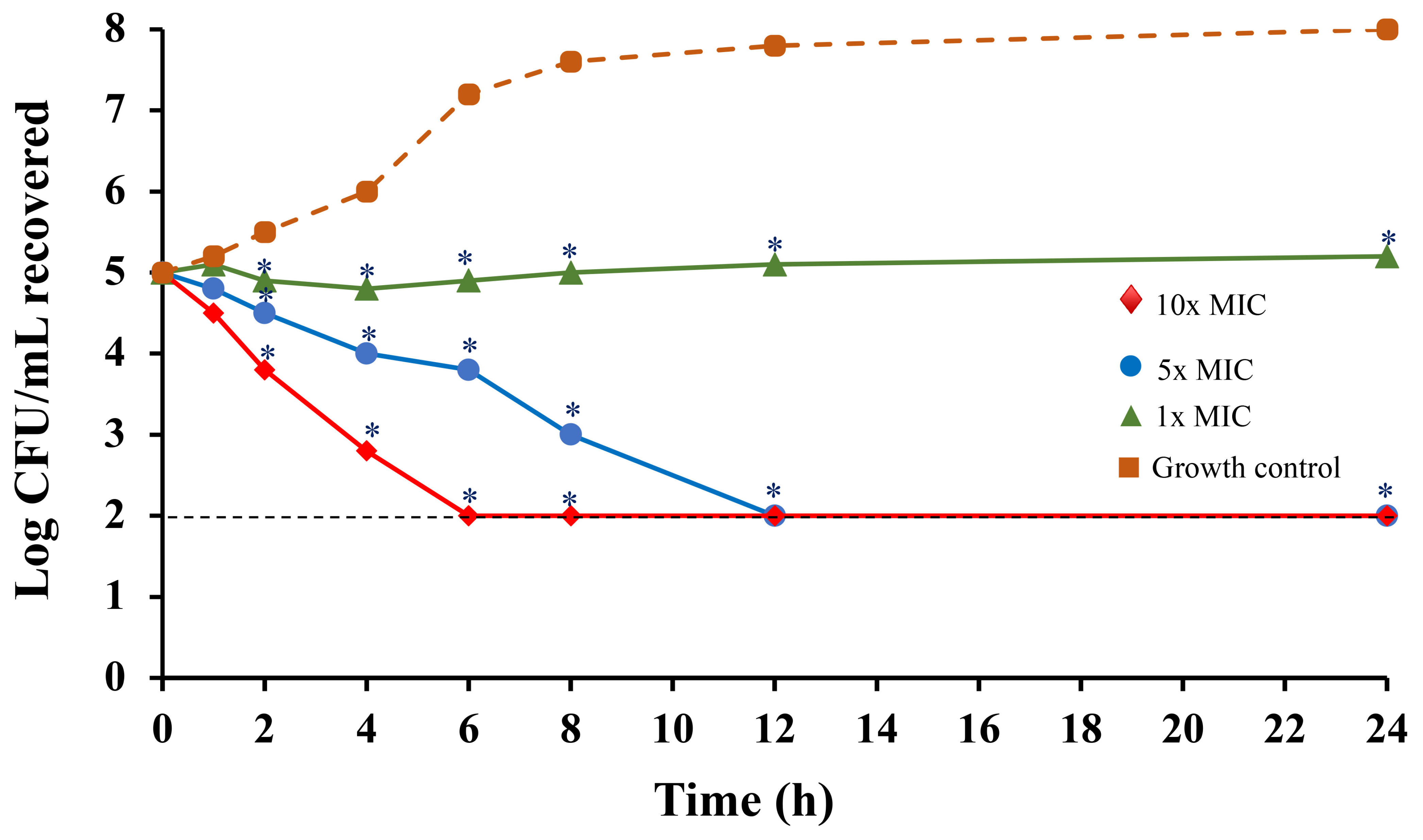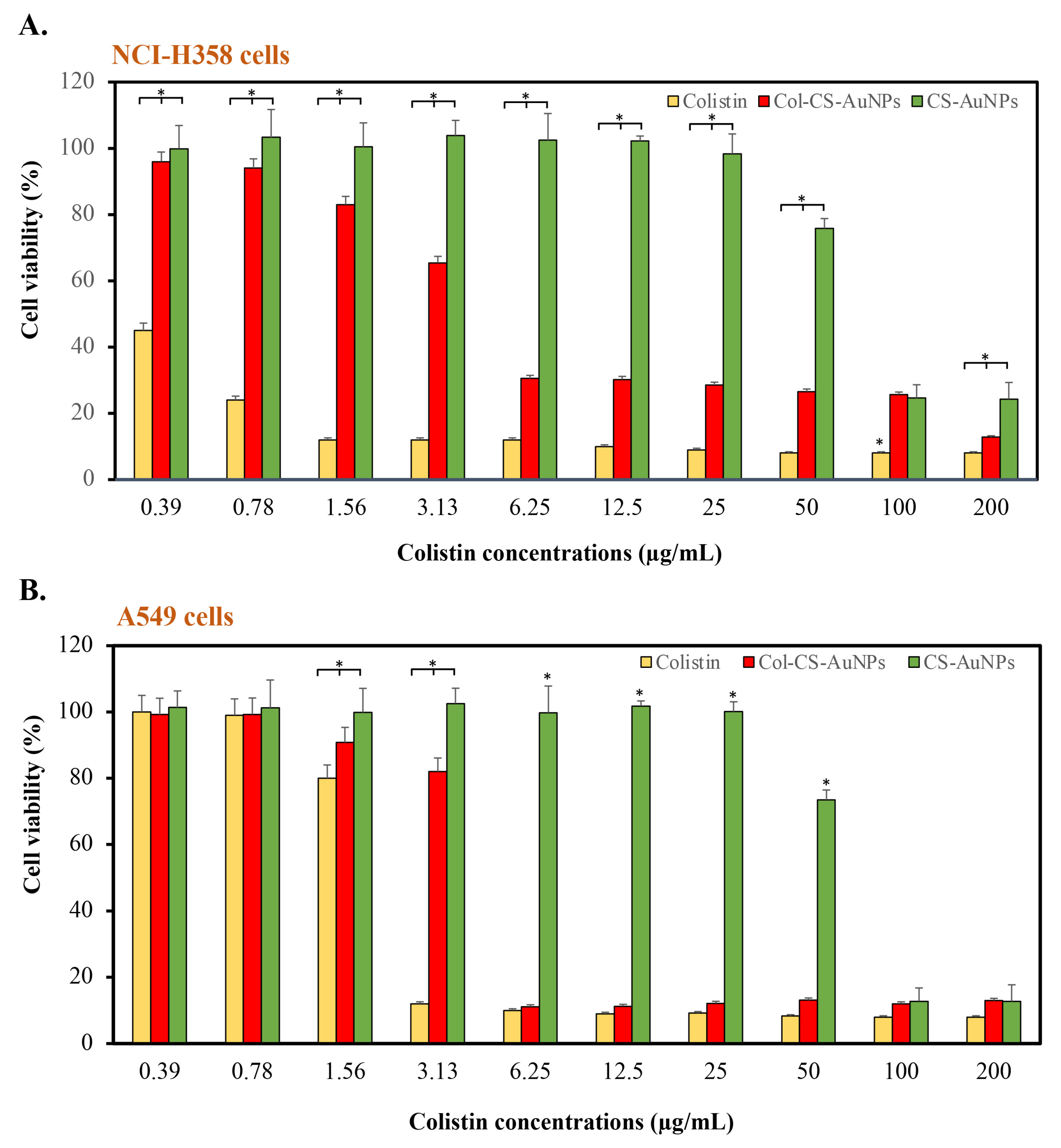In Vitro Evaluation of Colistin Conjugated with Chitosan-Capped Gold Nanoparticles as a Possible Formulation Applied in a Metered-Dose Inhaler
Abstract
:1. Introduction
2. Results and Discussion
2.1. Synthesis of Colistin Conjugated with Chitosan-Capped Gold Nanoparticles (Col-CS-AuNPs)
2.2. Physicochemical Properties of Col-CS-AuNPs
2.3. Controlled Release of Col-CS-AuNPs and Kinetic Models Fitting
2.4. Development of the Col-CS-AuNP MDI Formulations
2.5. Aerosol Properties of Col-CS-AuNP MDI Formulations
2.6. Antimicrobial Activity of Col-CS-AuNP MDI Product Concentrate
2.7. Cytotoxicity of Col-CS-AuNP MDI Formulations
2.8. Stability of Col-CS-AuNP MDI Formulations
3. Materials and Methods
3.1. Materials
3.2. Synthesis of Col-CS-AuNPs
3.3. Characterization of CS-AuNPs and Col-CS-AuNPs
3.3.1. Appearance
3.3.2. Particle Size Analysis and Zeta Potential
3.3.3. Fourier-Transform Infrared Spectroscopy
3.3.4. Morphology Examined Using a Scanning Electron Microscope
3.3.5. Nuclear Magnetic Resonance Spectroscopy (NMR)
3.3.6. Elemental Analysis
3.4. Analysis of Colistin Content in Col-CS-AuNPs
3.5. Entrapment Efficiency
3.6. Drug Release from Col-CS-AuNPs
3.7. Mechanism of Drug Release from Col-CS-AuNPs
3.8. Preparation of Col-CS-AuNP MDI Formulation
3.9. Aerosol Properties of Col-CS-AuNP MDI Formulation
3.10. Antimicrobial Activity of Col-CS-AuNP MDI Product Concentrate
3.11. Time-Kill Kinetic Assay
3.12. Cell Viability Test
3.12.1. Cell Culture Conditions
3.12.2. Cytotoxicity Test
3.13. Stability Study
4. Conclusions
Supplementary Materials
Author Contributions
Funding
Institutional Review Board Statement
Informed Consent Statement
Data Availability Statement
Acknowledgments
Conflicts of Interest
Abbreviations
References
- Ahmed, M.A.E.E.; Zhong, L.; Shen, C.; Zhong, L.; Shen, C.; Yang, Y.; Doi, Y.; Tian, G. Colistin and its role in the Era of antibiotic resistance: An extended review (200–2019). Emerg. Microbes. Infect. 2020, 9, 868–885. [Google Scholar] [CrossRef] [PubMed]
- Gurjar, M. Colistin for lung infection: An update. J. Intensive Care 2015, 3, 3. [Google Scholar] [CrossRef] [PubMed]
- Choe, J.; Sohn, Y.M.; Jeong, S.H.; Park, H.J.; Na, S.J.; Huh, K.; Suh, G.Y.; Jeon, K. Inhalation with intravenous loading dose of colistin in critically ill patients with pneumonia caused by carbapenem-resistant gram-negative bacteria. Ther. Adv. Respir. Dis. 2019, 13, 1–12. [Google Scholar] [CrossRef]
- Vardakas, K.Z.; Voulgaris, G.L.; Samonis, G.; Falagas, M.E. Inhaled colistin monotherapy for respiratory tract infections in adults without cystic fibrosis: A systematic review and meta-analysis. Int. J. Antimicrob. Agents. 2018, 51, 1–9. [Google Scholar] [CrossRef] [PubMed]
- Falagas, M.E.; Rizos, M.; Bliziotis, I.A.; Rellos, K.; Kasiakou, S.K.; Michalopoulos, A. Toxicity after prolonged (more than four weeks) administration of intravenous colistin. BMC Infect. Dis. 2005, 5, 1. [Google Scholar] [CrossRef] [PubMed]
- Almangour, T.A.; Alruwaili, A.; Almutairi, R.; Alrasheed, A.; Alhifany, A.A.; Eljaaly, K.; Alkofide, H.; Alhammad, A.M.; Gjonem, L.; Alsharidi, A. Aerosolized plus intravenous colistin vs intravenous colistin alone for the treatment of nosocomial pneumonia due to multidrug-resistant Gram-negative bacteria: A retrospective cohort study. Int. J. Infect. Dis. 2021, 108, 406–412. [Google Scholar] [CrossRef] [PubMed]
- Abdellatif, S.; Trifi, A.; Daly, F.; Mahjoub, K.; Nasri, R.; Lakhal, S.B. Efficacy and toxicity of aerosolized colistin in ventilator-associated pneumonia: A prospective, randomised trial. Ann. Intensive Care. 2016, 6, 26. [Google Scholar] [CrossRef]
- Almangour, T.A.; Alenazi, B.; Ghonem, L.; Alhifany, A.A.; Aldakheel, B.A.; Alruwaili, A. Inhaled colistin for the treatment of nosocomial pneumonia due to multidrug-resistant Gram-negative bacteria: A real-life experience in tertiary care hospitals in Saudi Arabia. Saudi Pharm. J. 2020, 28, 1009–1013. [Google Scholar] [CrossRef] [PubMed]
- Zhang, X.; Cui, X.; Jiang, M.; Huang, S.; Yang, M. Nebulized colistin as the adjunctive treatment for ventilator-associated pneumonia: A systematic review and meta-analysis. J. Crit. Care. 2023, 77, 154315. [Google Scholar] [CrossRef]
- Moghaddam, O.F.; Lahiji, M.N.; Talebi-Taher, M.; Mahmoodiyeh, B. Effect of inhaled colistin on the treatment of ventilator-associated pneumonia due to multi-drug resistant Acinetobacter. Tanaffos 2019, 18, 66–73. [Google Scholar]
- Lin, Y.; Zhou, Q.T.; Onufrak, N.J.; Sun, S.; Wang, J.; Forrest, A.; Chan, H.; Li, J. Pulmonary pharmacokinetics of colistin following administration of dry powder aerosols in rats. Antimicrob. Agents Chemother. 2017, 61, e00973-17. [Google Scholar] [CrossRef] [PubMed]
- Korbila, P.; Michalopoulos, A.; Rafailidis, P.I.; Nikita, D.; Samonis, G.; Falagas, M.E. Inhaled colistin as adjunctive therapy to intravenous colistin for the treatment of microbiologically documented ventilator-associated pneumonia: A comparative cohort study. Clin. Microbiol. Infect. 2010, 16, 1230–1236. [Google Scholar] [CrossRef] [PubMed]
- Myers, T.R. The science guiding selection of an aerosol delivery device. Respir. Care 2013, 58, 1963–1973. [Google Scholar] [CrossRef] [PubMed]
- Chandrakala, V.; Aruna, V.; Angajala, G. Review on metal nanoparticles as nanocarriers: Current challenges and perspectives in drug delivery systems. Emergent Mater. 2022, 5, 1593–1615. [Google Scholar] [CrossRef] [PubMed]
- Amina, S.J.; Guo, B. A review on the synthesis and functionalization of gold nanoparticles as a drug delivery vehicle. Int. J. Nanomed. 2020, 15, 9823–9857. [Google Scholar] [CrossRef] [PubMed]
- Alaqad, K.; Saleh, T.A. Gold and silver nanoparticles: Synthesis methods, characterization routes and applications towards drugs. J. Environ. Anal. Toxicol. 2016, 6, 4. [Google Scholar] [CrossRef]
- Rajchakit, U.; Sarojini, V. Recent developments in antimicrobial-peptide-conjugated gold nanoparticles. Bioconjugate Chem. 2017, 28, 2673–2686. [Google Scholar] [CrossRef] [PubMed]
- Zhang, Y.; Dasari, T.P.S.; Deng, H.; Yu, H. Antimicrobial activity of gold nanoparticles and ionic gold. J. Environ. Sci. Health C 2015, 33, 286–327. [Google Scholar] [CrossRef] [PubMed]
- Skłodowski, K.; Chmielewska-Deptuła, S.J.; Piktel, E.; Wolak, P.; Wollny, T.; Bucki, R. Metallic nanosystems in the development of antimicrobial strategies with high antimicrobial activity and high biocompatibility. Int. J. Mol. Sci. 2023, 24, 2104. [Google Scholar] [CrossRef]
- Franco, D.; Calabrese, G.; Guglielmino, S.P.P.; Conoci, S. Metal-based nanoparticles: Antibacterial mechanisms and biomedical application. Microorganisms 2022, 10, 1778. [Google Scholar] [CrossRef]
- Okkeh, M.; Bloise, N.; Restivo, E.; Vita, L.D.; Pallavicini, P.; Visai, L. Gold nanoparticles: Can they be the next magic bullet for multidrug-resistant bacteria? Nanomaterials 2021, 11, 312. [Google Scholar] [CrossRef] [PubMed]
- Fuller, M.; Whiley, H.; Köper, I. Antibiotic delivery using gold nanoparticles. SN Appl. Sci. 2020, 2, 1022. [Google Scholar] [CrossRef]
- De Jong, W.H.; Borm, P.J. Drug delivery and nanoparticles: Applications and hazards. Int. J. Nanomed. 2008, 3, 133–149. [Google Scholar] [CrossRef] [PubMed]
- Bisker, G.; Yeheskely-Hayon, D.; Minai, L.; Yelin, D. Controlled release of Rituximab from gold nanoparticles for phototherapy of malignant cells. J. Control. Release 2012, 162, 303–309. [Google Scholar] [CrossRef] [PubMed]
- Kumar, D.; Mutreja, I.; Meenan, B.J.; Dixon, D. The profile of payload release from gold nanoparticles modified with a BODIPY®/PEG mixed monolayer. J. Nano Res. 2013, 25, 16–30. [Google Scholar] [CrossRef]
- Duong, H.T.T.; Adnan, N.N.M.; Barraud, N.; Basuki, J.S.; Kutty, S.K.; Jung, K.; Kumar, N.; Davis, T.P.; Boyer, C. Functional gold nanoparticles for the storage and controlled release of nitric oxide: Applications in biofilm dispersal and intracellular delivery. J. Mater. Chem. B 2014, 2, 5003–5011. [Google Scholar] [CrossRef] [PubMed]
- England, C.G.; Miller, M.C.; Kuttan, A.; Trent, J.O.; Frieboes, H.B. Release kinetics of paclitaxel and cisplatin from two and three layered gold nanoparticles. Eur. J. Pharm. Biopharm. 2015, 92, 120–129. [Google Scholar] [CrossRef] [PubMed]
- Kalimuthu, K.; Lubin, B.; Bazylevich, A.; Gellerman, G.; Shpilberg, O.; Luboshits, G.; Firer, M.A. Gold nanoparticles stabilize peptide-drug-conjugates for sustained targeted drug delivery to cancer cells. J. Nanobiotechnol. 2018, 16, 34. [Google Scholar] [CrossRef] [PubMed]
- Hsieh, Y.; Chang, C.; Jen, I.; Pu, F.; Shen, S.; Wan, D.; Wang, J. Use of gold nanoparticles to investigate the drug embedding and releasing performance in biodegradable poly(glycerol sebacate). ACS Appl. Nano Mater. 2018, 1, 4474–4482. [Google Scholar] [CrossRef]
- Guerrero, A.; Hassan, N.; Escobar, C.A.; Albericio, F.; Kogan, M.J.; Araya, E. Gold nanoparticles for photothermally controlled drug release. Nanomedicine 2014, 9, 2023–2039. [Google Scholar] [CrossRef]
- Mathiyazhakan, M.; Wiraja, C.; Xu, C. A concise review of gold nanoparticles-based photo-responsive liposomes for controlled drug delivery. Nanomicro. Lett. 2018, 10, 10. [Google Scholar] [CrossRef] [PubMed]
- Bayat, F.; Karimi, A.R. Design of photodynamic chitosan hydrogels bearing phthalocyanine-colistin conjugate as an antibacterial agent. Int. J. Biol. Macromol. 2019, 129, 927–935. [Google Scholar] [CrossRef] [PubMed]
- Yeng, C.M.; Husseinsyah, S.; Ting, S.S. Corn cob filled chitosan biocomposite films. Adv. Mater. Res. 2013, 747, 649–652. [Google Scholar] [CrossRef]
- Aibani, N.; Rai, R.; Patel, P.; Cuddihy, G.; Wasan, E.K. Chitosan nanoparticles at the biological interface: Implications for drug delivery. Pharmaceutics 2021, 13, 1686. [Google Scholar] [CrossRef]
- Laaraibi, A.; Moughaoui, F.; Damiri, F.; Ouakit, A.; Charhouf, I.; Hamdouch, S.; Jaafari, A.; Abourriche, A.; Knouzi, N.; Bennamare, A.; et al. Chapter 3 Chitosan-clay based (CS-NaBNT) biodegradable nanocomposite films for potential utility in food and environment. In Chitin-Chitosan; Dongre, R., Ed.; IntechOpen Limited: London, UK, 2018; pp. 45–69. [Google Scholar] [CrossRef]
- Abrica-González, P.; Zamora-Justo, J.A.; Sotelo-López; Vázquez-Martínez, G.R.; Balderas-López, J.A.; Muñoz-Diosdado, A.; Ibáñez-Hernández, M. Gold nanoparticles with chitosan, N-acylated chitosan, and chitosan oligosaccharide as DNA carriers. Nanoscale Res. Lett. 2019, 14, 258. [Google Scholar] [CrossRef] [PubMed]
- Kumar-Krishnan, S.; Prokhorov, E.; Hernández-Iturriaga, M.; Mota-Morales, J.; Vázquez-Lape, M.; Kovalenko, Y.; Sanchez, I.C.; Luna-Bárcenas, G. Chitosan/silver nanocomposites: Synergistic antibacterial action of silver nanoparticles and silver ions. Eur. Polym. J. 2015, 67, 242–251. [Google Scholar] [CrossRef]
- Kumar, R.; Mehta, P.; Shankar, K.R.; Rajora, M.A.K.; Mishra, Y.K.; Mostafavi, E.; Kaushik, A. Nanotechnology-assisted metered-dose inhalers (MDIs) for high- performance pulmonary drug delivery applications. Pharm. Res. 2022, 39, 2831–2855. [Google Scholar] [CrossRef] [PubMed]
- Lanone, S.; Boczkowski, J. Titanium and gold nanoparticles in asthma: The bad and the ugly. Eur. Respir. J. 2011, 37, 225–227. [Google Scholar] [CrossRef] [PubMed]
- Berardis, B.D.; Marchetti, M.; Risuglia, A.; Ietto, F.; Fanizza, C.; Superti, F. Exposure to airborne gold nanoparticles: A review of current toxicological data on the respiratory tract. J. Nanopart. Res. 2020, 22, 235. [Google Scholar] [CrossRef]
- Kus-Liśkiewicz, M.; Fickers, P.; Tahar, I.B. Biocompatibility and cytotoxicity of gold nanoparticles: Recent advances in methodologies and regulations. Int. J. Mol. Sci. 2021, 22, 10952. [Google Scholar] [CrossRef]
- Urso, A.; Meloni, F.; Malatesta, M.; Latorre, R.; Damoci, C.; Crapanzano, J.; Pandolfi, L.; Giustra, M.D.; Pearson, M.; Colombo, M.; et al. Endotrachial nebulization of gold nanoparticles for noninvasive pulmonary drug delivery. Nanomedicine 2023, 18, 317–330. [Google Scholar] [CrossRef] [PubMed]
- Niznik, Ł.; Noga, M.; Kobylarz, D.; Frydrych, A.; Krosniak, A.; Kapka-Skrzypczak, L.; Jurowski, K. Gold nanoparticles (AuNPs)—Toxicity, safety and green synthesis: A critical review. Int. J. Mol. Sci. 2024, 25, 4057. [Google Scholar] [CrossRef] [PubMed]
- Mohan, C.O.; Gunasekaran, S.; Ravishankar, C.N. Chitosan-capped gold nanoparticles for indicating temperature abuse in frozen stored products. npj Sci. Food 2019, 3, 2. [Google Scholar] [CrossRef] [PubMed]
- Subara, D.; Jaswir, I. Gold nanoparticles: Synthesis and application for halal authentication in meat and meat products. Int. J. Adv. Sci. Eng. Inf. Techno. 2018, 4, 1633–1641. [Google Scholar] [CrossRef]
- Wang, C.; Astruc, D. Nanogold plasmonic photocatalysis for organic synthesis and clean energy conversion. Chem. Soc. Rev. 2014, 43, 7188. [Google Scholar] [CrossRef] [PubMed]
- Mody, V.V.; Siwale, R.; Singh, A.; Mody, H.R. Introduction to metallic nanoparticles. J. Pharm. Bioallied Sci. 2010, 2, 282–289. [Google Scholar] [CrossRef] [PubMed]
- Danaei, M.; Dehghankhold, M.; Ataei, S.; Davarani, F.H.; Javanmad, R.; Dokhani, A.; Khorasani, S.; Mozafari, M.R. Impact of particle size and polydispersity index on the clinical applications of lipidic nanocarrier systems. Pharmaceutics 2018, 10, 57. [Google Scholar] [CrossRef] [PubMed]
- Fissan, H.; Ristig, S.; Kaminski, H.; Asbach, C.; Epple, M. Comparison of different characterization methods for nanoparticle dispersions before and after aerosolization. Anal. Methods 2014, 6, 7324. [Google Scholar] [CrossRef]
- Filippov, S.K.; Khusnutdinov, R.; Murmiliuk, A.; Inam, W.; Zakharova, L.Y.; Zhang, H.; Khutoryanskiy, V.V. Dynamic light scattering and transmission electron microscopy in drug delivery: A roadmap for correct characterization of nanoparticles and interpretation of results. Mater. Horiz. 2023, 10, 5354. [Google Scholar] [CrossRef]
- Fuster, M.G.; Montalbán, M.G.; Carissimi, G.; Lima, B.; Feresin, G.E.; Cano, M.; Giner-Casares, J.J.; López-Cascales, J.J.; Enriz, R.D.; Vilora, G. Antibacterial effect of chitosan–gold nanoparticles and computational modeling of the interaction between chitosan and a lipid bilayer model. Nanomaterials 2020, 10, 2340. [Google Scholar] [CrossRef]
- Khare, T.; Mahalunkar, S.; Shriram, V.; Gosavi, S. Embelin-loaded chitosan gold nanoparticles interact synergistically with ciprofloxacin by inhibiting efflux pumps in multidrug-resistant Pseudomonas aeruginosa and Escherichia coli. Environ. Res. 2021, 199, 111321. [Google Scholar] [CrossRef] [PubMed]
- Muenraya, P.; Sawatdee, S.; Srichana, T.; Atipairin, A. Silver nanoparticles conjugated with colistin enhanced the antimicrobial activity against gram-negative bacteria. Molecules 2022, 27, 5780. [Google Scholar] [CrossRef] [PubMed]
- Pavia, D.L.; Lampman, G.M.; Kriz, G.S. Chapter 2 Infrared Spectroscopy. In Introduction to Spectroscopy: A Guide for Students of Organic Chemistry; Thomson Learning Inc.: Chicago, IL, USA, 2001; pp. 13–101. [Google Scholar]
- ICH. ICH Guideline Q2(R2) on Validation of Analytical Procedures; European Medicines Agency: Amsterdam, The Netherlands, 2022. [Google Scholar]
- Bhumkar, D.R.; Joshi, H.M.; Sastry, M.; Pokharkar, V.B. Chitosan reduced gold nanoparticles as novel carriers for transmucosal delivery of insulin. Pharm. Res. 2007, 24, 1415–1426. [Google Scholar] [CrossRef] [PubMed]
- Thanayutsiri, T.; Patrojanasophon, P.; Opanasopit, P.; Ngawhirunpat, T.; Plianwong, S.; Rojanarata, T. Rapid synthesis of chitosan-capped gold nanoparticles for analytical application and facile recovery of gold from laboratory waste. Carbohydr. Polym. 2020, 250, 116983. [Google Scholar] [CrossRef] [PubMed]
- Çiftçi, H.; Alver, E.; Çelik, F.; Metin, A.Ü.; Tamer, U. Non-enzymatic sensing of glucose using a glassy carbon electrode modified with gold nanoparticles coated with polyethyleneimine and 3-aminophenylboronic acid. Microchim. Acta 2016, 183, 1479–1486. [Google Scholar] [CrossRef]
- Bui, T.H.; Lee, W.; Jeon, S.; Kim, K.; Lee, Y. Enhanced gold(III) adsorption using glutaraldehyde-crosslinked chitosan beads: Effect of crosslinking degree on adsorption selectivity, capacity, and mechanism. Sep. Purif. Technol. 2020, 248, 116989. [Google Scholar] [CrossRef]
- Oberdörster, G. Lung dosimetry: Pulmonary clearance of inhaled particles. Aerosol Sci. Technol. 1993, 18, 279–289. [Google Scholar] [CrossRef]
- Chaurasiya, B.; Zhao, Y.Y. Dry powder for pulmonary delivery: A comprehensive review. Pharmaceutics. 2021, 13, 31. [Google Scholar] [CrossRef] [PubMed]
- Stuart, B.O. Deposition and clearance of inhaled particles. Environ. Health Perspect. 1984, 55, 369–390. [Google Scholar] [CrossRef]
- Lu, Q.; Girardi, C.; Zhang, M.; Bouhemad, B.; Louchahi, K.; Petitjean, O.; Wallet, F.; Becquemin, M.; Naour, G.L.; Marquette, C.; et al. Nebulized and intravenous colistin in experimental pneumonia caused by Pseudomonas aeruginosa. Intensive Care Med. 2010, 36, 1147–1155. [Google Scholar] [CrossRef]
- Siepmann, J.; Peppas, N.A. Modeling of drug release from delivery systems based on hydroxypropyl methylcellulose (HPMC). Adv. Drug. Deliv. Rev. 2001, 48, 139–157. [Google Scholar] [CrossRef] [PubMed]
- Oka, H.; Ito, Y. Antibiotics: High-speed countercurrent chromatography. In Encyclopedia of Separation Science; Academic Press: Cambridge, MA, USA, 2000. [Google Scholar]
- Blaškovičová, J.; Vyskočil, V.; Augustín, M.; Purdešová, A. Ethanol and NaCl-induced gold nanoparticle aggregation toxicity toward DNA investigated with a DNA/GCE biosensor. Sensors 2023, 23, 3425. [Google Scholar] [CrossRef] [PubMed]
- Smyth, H.D.C. The influence of formulation variables on the performance of alternative propellant-driven metered dose inhalers. Adv. Drug Deliv. Rev. 2003, 55, 807–828. [Google Scholar] [CrossRef] [PubMed]
- Wallin, C.J.; Leksell, G. Estimation of extravascular lung water in humans with use of D2O: Effect of blood flow and central blood volume. J. Appl. Physiol. 1994, 76, 1868–1875. [Google Scholar] [CrossRef] [PubMed]
- Michard, F.; Schachtrupp, A.; Toens, C. Factors influencing the estimation of extravascular lung water by transpulmonary thermodilution in critically ill patients. Crit. Care Med. 2005, 33, 1243–1247. [Google Scholar] [CrossRef] [PubMed]
- Myrdal, P.B.; Sheth, P.; Stein, S.W. Advanced in metered dose inhaler technology: Formulation development. AAPS Pharmscitech 2014, 15, 434–455. [Google Scholar] [CrossRef] [PubMed]
- Haghi, M.; Traini, D.; Young, P. In vitro cell integrated impactor deposition methodology for the study of aerodynamically relevant size fractions from commercial pressurised metered dose inhalers. Pharm. Res. 2014, 31, 1779–1787. [Google Scholar] [CrossRef] [PubMed]
- Costa, A.; Pinheiro, M.; Magalhães, J.; Ribeiro, R.; Seabra, V.; Reis, S.; Sarmento, B. The formulation of nanomedicines for treating tuberculosis. Adv. Drug Deliv. Rev. 2016, 102, 102–115. [Google Scholar] [CrossRef] [PubMed]
- Rubin, B.K.; Fink, J.B. Optimizing aerosol delivery by pressurized metered-dose inhalers. Respir. Care 2005, 50, 1191–1200. [Google Scholar]
- Tena, A.F.; Clarà, P.C. Deposition of inhaled particles in the lungs. Arch. Bronconeumol. 2012, 48, 240–246. [Google Scholar] [CrossRef]
- Hinds, W.C.; Zhu, Y. Aerosol Technology: Properties, Behavior, and Measurement of Airborne Particles, 3rd ed.; John Wiley & Son Inc.: Hoboken, NJ, USA, 2022. [Google Scholar]
- United States Pharmacopeia Convention Committee of Revision. United States Pharmacopeia—National Formulary, 43rd ed.; United States Pharmacopeial Convention: Rockville, MA, USA, 2021. [Google Scholar]
- Perni, S.; Prokopovichi, P. Continuous release of gentamicin from gold nanocarriers. RSC Adv. 2014, 4, 51904–51910. [Google Scholar] [CrossRef] [PubMed]
- Dubashynskaya, N.V.; Bokatyi, A.N.; Dobrodumov, A.V.; Kudryavtsev, I.V.; Trulioff, A.S.; Rubinstein, A.A.; Aquino, A.D.; Dubrovskii, Y.A.; Knyazeva, E.S.; Demyanova, E.V.; et al. Succinyl chitosan-colistin conjugates as promising drug delivery systems. Int. J. Mol. Sci. 2023, 24, 166. [Google Scholar] [CrossRef]
- Hashem, A.H.; Shehabeldine, A.M.; Ali, O.M.; Salem, S.S. Synthesis of chitosan-based golf nanoparticles: Antimicrobial and wound-healing activities. Polymers 2022, 14, 2293. [Google Scholar] [CrossRef] [PubMed]
- Huang, Y.W.; Cambre, M.; Lee, H.J. The toxicity of nanoparticles depends on multiple molecular and physicochemical mechanisms. Int. J. Mol. Sci. 2017, 18, 2702. [Google Scholar] [CrossRef] [PubMed]
- Chen, G.; Kronenberger, P.; Teugels, E.; Umelo, I.A.; Grève, J.D. Targeting the epidermal growth factor receptor in non-small cell lung cancer cells: The effect of combining RNA interference with tyrosine kinase inhibitors or cetuximab. BMC Med. 2012, 10, 28. [Google Scholar] [CrossRef] [PubMed]
- Lu, Q.; Luo, R.; Bodin, L.; Yang, J.; Zahr, N.; Aubry, A.; Golmard, J.; Rouby, J.; Nebulized Antibiotics Study Group. Efficacy of high-dose nebulized colistin in ventilator-associated pneumonia caused by multidrug-resistant Pseudomonas aeruginosa and Acinetobacter baumannii. Anesthesiology 2012, 117, 1335–1347. [Google Scholar] [CrossRef] [PubMed]
- González-González, O.; Ramirez, I.O.; Ramirez, B.I.; O’Connell, P.; Ballesteros, M.P.; Torrado, J.J.; Serano, D.R. Drug stability: ICH versus accelerated predictive stability studies. Pharmaceutics 2022, 14, 2324. [Google Scholar] [CrossRef] [PubMed]
- Shoyele, S.A.; Slowey, A. Prospects of formulating proteins/peptides as aerosols for pulmonary drug delivery. Int. J. Pharm. 2006, 314, 1–8. [Google Scholar] [CrossRef] [PubMed]
- Morales, J.O.; Fathe, K.R.; Brunaugh, A.; Ferrati, S.; Li, S.; Montenegro-Nicolini, M.; Mousavikhamene, Z.; McConville, J.T.; Prausnitz, M.R.; Smyth, H.D.C. Challenges and future prospects for the delivery of biologics: Oral mucosal, pulmonary, and transdermal routes. AAPS J. 2017, 19, 652–668. [Google Scholar] [CrossRef]
- Matthews, A.A.; Ee, P.L.R.; Ge, R. Developing inhaled protein therapeutics for lung diseases. Mol. Biomed. 2020, 1, 11. [Google Scholar] [CrossRef]
- Quinn, É.Á.; Forbes, R.T.; Williams, A.C.; Oliver, M.J.; McKenzie, L.; Purewal, T.S. Protein conformational stability in the hydrofluoroalkane propellants tetrafluoroethane and heptafluoropropane analysed by Fourier transform Raman spectroscopy. Int. J. Pharm. 1999, 186, 31–41. [Google Scholar] [CrossRef] [PubMed]
- Choosakoonkriang, S.; Supaluknari, S.; Puangkaew, P. High performance liquid chromatographic method for determination of colistin sulfate and its application in medicated premix and animal feed. Int. J. Sci. Res. 2013, 7, 224–228. [Google Scholar]
- Thai Food and Drug Administration. ASEAN Guideline on Analytical Validation. In ASEAN Guideline on Stability of Drug Products, 1st ed.; Bureau of Drug Control: Nonthaburi, Thailand, 2004; pp. 1–18. [Google Scholar]
- Yasir, M.; Dutta, D.; Willcox, M.D.P. Mode of action of the antimicrobial peptide Mel4 is independent of Staphylococcus aureus cell membrane permeability. PLoS ONE 2019, 14, e0215703. [Google Scholar] [CrossRef] [PubMed]






| Particles | Particle Size, Z-Average (nm) | Polydispersity Index (PDI) | Zeta Potential (mV) |
|---|---|---|---|
| CS-AuNPs | 44.34 ± 1.02 | 0.22 ± 0.01 | +1.13 ± 0.01 |
| Col-CS-AuNPs | 174.50 ± 4.46 | 0.10 ± 0.01 | +4.97 ± 1.05 |
| Model of Drug Release | Rate Constant | Correlation Coefficients (R2) | |
|---|---|---|---|
| Zero-order | k0 | 0.1794 | 0.4951 |
| First-order | k1 | 0.0024 | 0.7563 |
| Higuchi | kH | 3.2782 | 0.6646 |
| Korsmeyer–Peppas | n | 0.1201 | 0.9531 |
| Test Parameters | Results |
|---|---|
| Assay (% Labeled claim of colistin) | 98.64% ± 2.34 |
| Delivered dose uniformity | BOU: 95.05% ± 4.08% EOU: 96.45% ± 1.33% |
| MMAD (μm) | 2.34 ± 1.01 |
| GSD | 0.21 ± 0.02 |
| ED (μg) | 88.5 ± 1.85 |
| FPF (%) | 61.08 ± 2.03 |
| FPD (μg) | 61.08 ± 2.03 |
| Sample | MIC (μg/mL) against E. coli TISTR 887 | MBC (μg/mL) against E. coli TISTR 887 |
|---|---|---|
| Colistin | 4 ± 0.00 | 4 ± 0.00 |
| Col-CS-AuNPs | 8 ± 0.00 | 8 ± 0.00 |
| CS-AuNPs | 128 ± 0.00 | 128 ± 0.00 |
| Col-CS-AuNP MDI product concentrate | 8 ± 0.00 | 8 ± 0.00 |
| Test Parameters | Initial Results | After 3 Months of Storage |
|---|---|---|
| Col-CS-AuNPs (stored at 2–8 °C) | ||
| Appearance | Red wine color colloidal solution | Red wine color colloidal solution |
| Content of colistin (%w/w) | 2.84 ± 0.50 | 2.79 ± 0.21 |
| Particle size (Z-average, nm) | 174.50 ± 4.46 | 186.30 ± 3.65 |
| Polydispersity index | 0.10 ± 0.01 | 0.12 ± 0.02 |
| Zeta potential (mV) | 4.97 ± 1.05 | 5.74 ± 0.85 |
| Col-CS-AuNP MDI formulation (stored at 30 ± 2 °C/75 ± 5% relative humidity) | ||
| Assay (%Labeled claim of colistin) | 98.64 ± 2.34 | 101.52 ± 1.40 |
| Delivered dose uniformity | BOU: 95.05% ± 4.08% EOU: 96.45% ± 1.33% | BOU: 92.34% ± 1.70% EOU: 94.10% ± 2.09% |
| MMAD (μm) | 2.34 ± 1.01 | 2.87 ± 1.74 |
| GSD | 0.21 ± 0.02 | 0.22 ± 0.01 |
| ED (μg) | 17.70 ± 1.22 | 20.14 ± 1.68 |
| FPF (%) | 61.08 ± 2.03 | 55.48 ± 3.10 |
| FPD (μg) | 61.08 ± 2.03 | 55.48 ± 3.10 |
| Ingredients | Amount (g) | Function |
|---|---|---|
| Col-CS-AuNPs (equivalent to colistin 0.02 g) * | 0.700 | Active ingredient |
| Absolute ethanol | 1.00 | Vehicle of product concentrate |
| Sorbitan monooleate | 0.005 | Surfactant (valve lubricant and stabilizing agent) |
| HFA-134a qs to | 10.00 mL | Propellant |
Disclaimer/Publisher’s Note: The statements, opinions and data contained in all publications are solely those of the individual author(s) and contributor(s) and not of MDPI and/or the editor(s). MDPI and/or the editor(s) disclaim responsibility for any injury to people or property resulting from any ideas, methods, instructions or products referred to in the content. |
© 2024 by the authors. Licensee MDPI, Basel, Switzerland. This article is an open access article distributed under the terms and conditions of the Creative Commons Attribution (CC BY) license (https://creativecommons.org/licenses/by/4.0/).
Share and Cite
Changsan, N.; Atipairin, A.; Muenraya, P.; Sritharadol, R.; Srichana, T.; Balekar, N.; Sawatdee, S. In Vitro Evaluation of Colistin Conjugated with Chitosan-Capped Gold Nanoparticles as a Possible Formulation Applied in a Metered-Dose Inhaler. Antibiotics 2024, 13, 630. https://doi.org/10.3390/antibiotics13070630
Changsan N, Atipairin A, Muenraya P, Sritharadol R, Srichana T, Balekar N, Sawatdee S. In Vitro Evaluation of Colistin Conjugated with Chitosan-Capped Gold Nanoparticles as a Possible Formulation Applied in a Metered-Dose Inhaler. Antibiotics. 2024; 13(7):630. https://doi.org/10.3390/antibiotics13070630
Chicago/Turabian StyleChangsan, Narumon, Apichart Atipairin, Poowadon Muenraya, Rutthapol Sritharadol, Teerapol Srichana, Neelam Balekar, and Somchai Sawatdee. 2024. "In Vitro Evaluation of Colistin Conjugated with Chitosan-Capped Gold Nanoparticles as a Possible Formulation Applied in a Metered-Dose Inhaler" Antibiotics 13, no. 7: 630. https://doi.org/10.3390/antibiotics13070630







